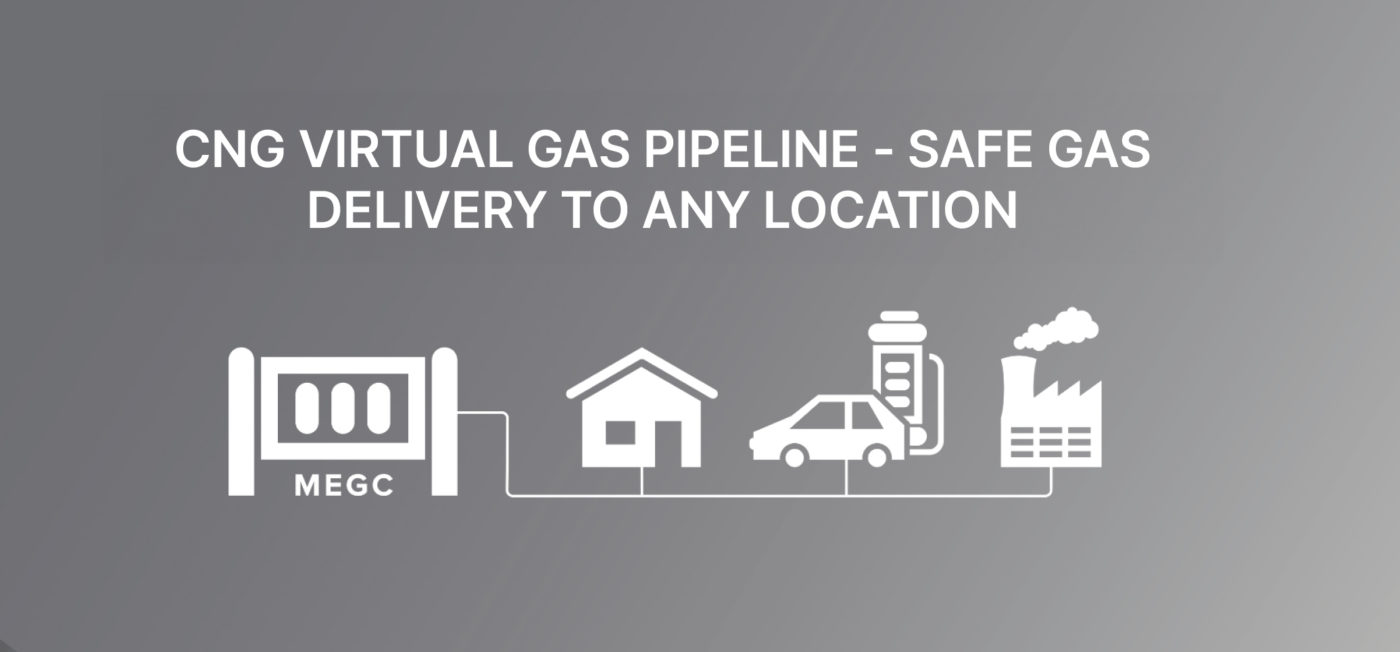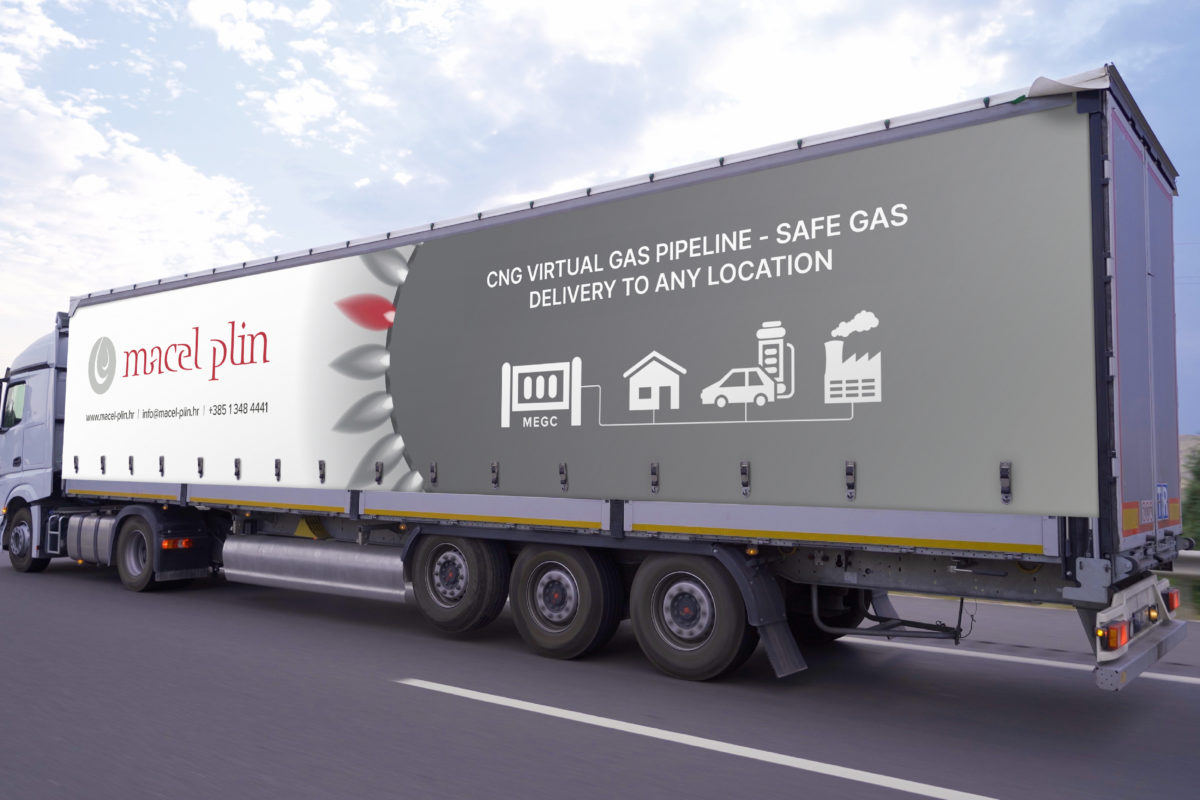Multiple-element gas containers (MEGC) enable gas transportation from point A to point B, where conventional infrastructure is unavailable or uneconomical. This ensures continuous gas supply even in the most challenging circumstances.
MEGC has emerged as a cutting-edge solution to address the challenges associated with gas transportation, including CNG, hydrogen, biogas, etc. MEGCs offer many advantages, combining safety, efficiency, and versatility to meet the demands of diverse sectors.
In this article, discover more about MEGC and its advantages in storing and transporting gas and CNG.
What is a MEGC?
Ensuring an uninterrupted gas supply is crucial. If a gas pipeline needs repairs (cutting out a corroded section, for example), it’s essential to maintain the gas supply to households.
The multi-element gas containers typically transport and distribute large amounts of gas under high pressure (200–300 bars).
MEGC is constructed with multiple compartments and adheres to international specifications and regulations. This ensures compatibility with various transportation modes, including road, rail, and sea.
Mobile storage for virtual pipelines
Equipped with a semi-trailer, MEGC by Macel Plin offers dedicated mobile storage for virtual pipelines. This enables the transportation of gases to remote or temporary sites where traditional pipeline infrastructure is unavailable or impractical. With the flexibility of mobile storage, our MEGC empowers companies to reach new markets and expand gas distribution networks easily.
Virtual pipelines are a crucial link between natural gas suppliers and end customers, facilitating gas transportation through tankers. This system is a bridge, ensuring seamless gas delivery from the supplier to the final destination without traditional pipeline infrastructure.
Advantages of MEGC
Flexibility and adaptability
One of the main advantages of using MEGC is its flexibility and adaptability. These containers can serve as backup solutions in emergencies or temporary alternatives when the conventional gas supply is hindered. For example, during pipeline maintenance or infrastructure shortages.
Versatility in gas types
MEGCs can accommodate various gases, from CNG to biomethane, hydrogen, etc.
The modular design allows for customization based on the specific requirements of different gases, ensuring compatibility and safety during transportation. This versatility makes MEGCs a preferred choice for industries with diverse gas transport needs.
Safety and efficiency
Regular maintenance and inspections ensure the safety and efficiency of MEGC. The entire production process of MEGC is monitored by the relevant “Notified Body”, which monitors every segment of production and installed materials.
Mobile pressurized equipment has a Pi (π) marking. The Pi mark indicates compliance with EU transportable pressure equipment regulations, ensuring safety and quality standard adherence.

Multiple element gas container (MEGC) with semi-trailer by Macel Plin
Initially developed for the Oil refinery Brod JSC (Bosnia and Herzegovina), where the lack of gas pipelines and infrastructure necessitates alternative solutions, MEGC containers have proven beneficial.
Given the various types of gases and diverse customer requirements, MEGC can be customized to meet specific needs. For example, containers can be tailored to different dimensions, capacities, and pressures. These containers enable the safe transportation of various gas types, such as compressed natural gas (CNG) or high-pressure hydrogen.
This product combines the versatility of MEGC with the mobility of semi-trailers, offering dedicated mobile storage for virtual pipelines. Their application is not limited to natural gas alone. A wide range of industrial and medical gases, such as CNG, hydrogen, argon, and biogas, can also be transported via these containers.
Technical specifications for CNG
| Product name | Type of cylinders | Total capacity (Nm3) | Pressure operation (bar) | Number of cylinders (pcs) | Water capacity of 1 cylinder (I) | Weight of empty container (kg) + semi-trailer | Cylinder position |
| MEGC | II type, double neck | 5400 | 250 | 123 | 150 | 27.000 | Vertical |
Key features:
- Type I, II, III, and IV cylinders: Our MEGC is engineered to transport Type I, II, III, and IV cylinders, ensuring compatibility with various gases. Whether CNG, methane, biogas, or hydrogen, this container is designed to meet the specific requirements of different gas types, providing flexibility and versatility for diverse applications.
- Built to endure rough road conditions: Designed for durability, our MEGC is built to withstand rough road conditions encountered during transportation. The container ensures the safe and secure transport of gases without compromising integrity or performance.
- Regulatory compliance and safety: Our MEGCs are designed and manufactured to meet rigorous safety standards and regulatory requirements, including ADR/TPED approvals. Adhering to these standards ensures that companies using MEGCs for gas transport meet legal requirements, avoid potential penalties, and ensure safety and compliance throughout the gas transportation process. The relevant “Notified Body” closely monitors every step of our MEGC production, ensuring quality control of materials and processes.
- Tailor-made hydraulic capacity: It allows for efficient loading and unloading of gases, optimizing operational effectiveness and minimizing downtime. Whether filling at high or low temperatures, our MEGC delivers consistent performance and reliability, ensuring seamless gas transport operations in any environment.
- Leak-free design: The MEGC boasts a leak-free design. This ensures that gases are transported safely and efficiently without the risk of leaks or spills that could pose environmental or safety hazards.
- Customized design for optimal performance: The construction and cylinder selection of our MEGCs are fully customizable and tailored to the medium, working conditions, and technical specifications according to the customer’s unique requirements. This personalized approach ensures optimal performance and efficiency in gas transportation, regardless of the operating environment.
What are the different types of CNG cylinders?
Four distinct cylinder types are available for high-pressure vessels (HPV) to store CNG and hydrogen. Each is designed to meet specific durability, weight, and safety requirements.
- Type 1 consists of steel cylinders. While sturdy, they tend to be heavier compared to newer alternatives.
- Type 2 features steel cylinders reinforced with composite materials, offering an improved strength-to-weight ratio compared to Type 1.
- Type 3 utilizes a composite cylinder with a metal liner, combining the lightweight advantage of composites with the added durability of metal.
- Type 4 employs a composite structure with a polymer liner, optimizing weight reduction while maintaining structural integrity and safety standards.
Type 4 composite cylinders achieve a weight reduction of approximately 70% compared to Type 1 and 2 steel cylinders and 25% to 35% compared to Type 3 aluminum liner-based cylinders.
These different types of CNG cylinders provide options for various applications, ensuring flexibility and efficiency in storing compressed natural gas.
What is the common use of CNG?
Compressed natural gas is primarily used as an alternative fuel for powering vehicles. However, its utility extends beyond transportation, with applications in power generation, water heating, and air conditioning systems.
CNG is increasingly used in power generation, serving as a cleaner-burning fuel than coal or oil. It also contributes to efforts to transition towards more sustainable and environmentally friendly energy sources.
MEGC is deployed to deliver CNG beyond the work location for pipeline repair. This prevents households from being left without gas during maintenance work. This ensures that consumers continue to receive a steady gas supply, even amidst infrastructure maintenance or repairs.
Conclusion
Multiple-element gas containers offer many advantages, prioritizing safety and efficiency.
With their enhanced safety features, versatility in accommodating various gases, and ability to optimize space and resources, multiple-element gas containers provide a comprehensive solution for worldwide industries’ diverse needs.
MEGC stands out as a reliable choice for ensuring continuous and safe gas delivery in the context of future technological developments and global trade and logistics changes. Its adaptability, safety, and ability to respond quickly to emergencies make it a valuable tool in the gas transportation industry.
MEGC is a crucial solution for delivering gas to areas lacking developed gas pipeline networks or experiencing interruptions. Acting as a virtual gas pipeline, it ensures continuous gas supply even in pipeline downtime, reaffirming its significance in bridging energy gaps and maintaining uninterrupted service.


 Hrvatski
Hrvatski